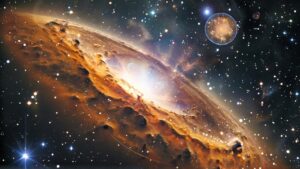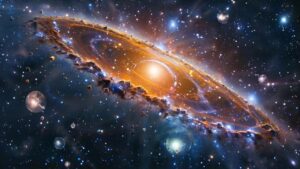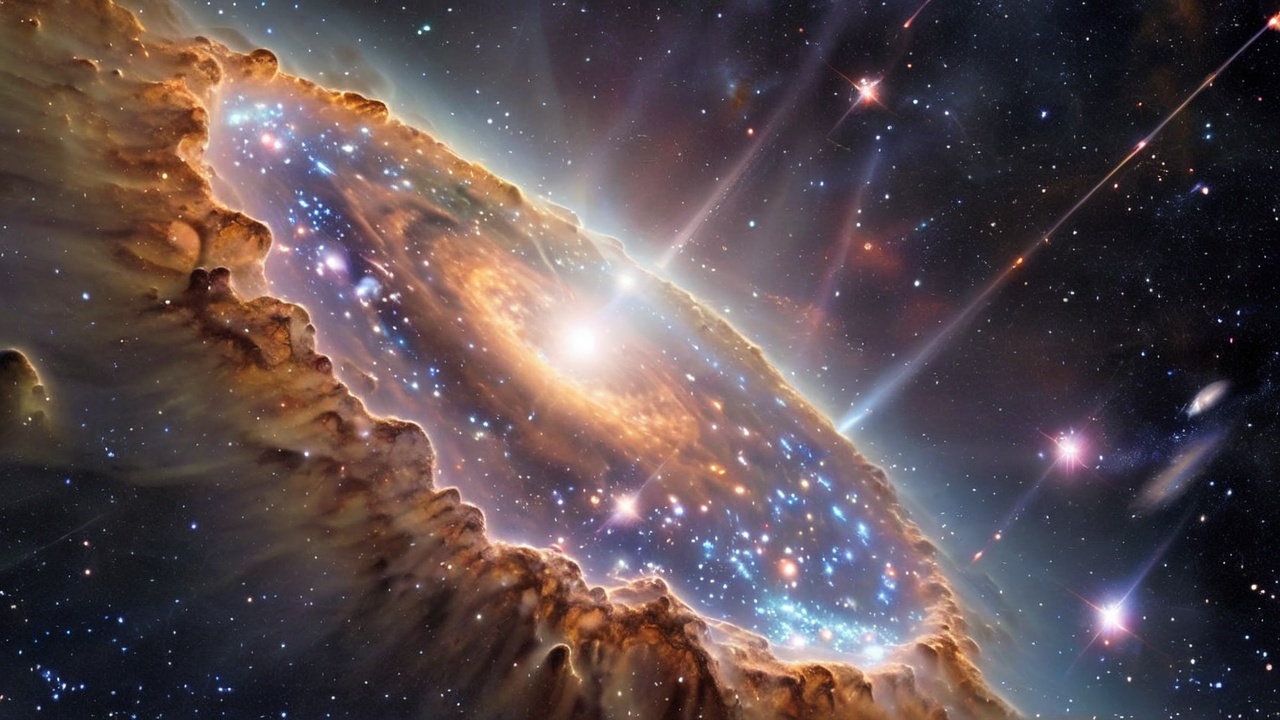Introduction to Stellar Bubbles
Stellar bubbles are intriguing phenomena observed on the surfaces of stars, characterized by the expulsion of stellar material and energy. As stars undergo various life stages, they can generate bubbles through processes tied to their internal dynamics and external influences. Recent advancements in astronomical research have brought significant attention to these bubbles, revealing their essential role in enhancing our understanding of stellar evolution and characteristics.
The recent discovery made by astronomers tracking these stellar bubbles represents a breakthrough in the field. Utilizing innovative techniques and cutting-edge technology, astronomers have successfully captured the dynamics and physical properties of these bubbles as they form and collapse on a star’s surface. Observations conducted with high-resolution imaging and spectroscopy have allowed researchers to examine the gas cloud’s composition and behavior, offering intricate details of stellar atmospheres.
These discoveries have far-reaching implications for our comprehension of various cosmic phenomena. Stellar bubbles contribute to the recycling of materials within galaxies by dispersing elements into the interstellar medium, directly affecting star formation and galactic evolution. Furthermore, understanding these bubbles can yield insights into the life cycle of stars and their eventual demise, providing context for more massive celestial structures and the dynamics of the universe.
The innovative observational techniques employed in tracking stellar bubbles mark a significant evolution in modern astronomy. By combining multi-wavelength observations and advanced computational models, astronomers can sift through vast amounts of data to identify patterns and behaviors that were previously elusive. This multifaceted approach continues to enhance our understanding of the complex processes governing stellar formation and destruction, ultimately enriching the broader realm of astrophysics.
Technology Behind the Discovery
Recent advancements in telescopic technology and observational methodologies have illuminated the phenomenon of stellar bubbles in unprecedented ways. Astronomers have employed high-resolution imaging techniques that provide detailed views of stellar surfaces, allowing scientists to monitor these cosmic structures in real time. Instruments such as the Atacama Large Millimeter/submillimeter Array (ALMA) and the Very Large Telescope (VLT) are pivotal in capturing the intricate details of these phenomena, revealing the dynamics of stellar activity.
High-resolution imaging allows astronomers to resolve fine features on stars which are otherwise obscured by distance and atmospheric interference. This technology utilizes adaptive optics, correcting for atmospheric distortions and enabling sharper images. By improving the clarity of images, astronomers can better analyze the physical properties of stellar bubbles, including their size, composition, and motion.
In addition to imaging, spectroscopy plays a crucial role in this discovery. Spectroscopy involves analyzing the light emitted by stars to identify their chemical composition, temperature, and velocity. By studying the spectrum of light, researchers can distinguish the elements present and observe shifts in wavelengths, which indicate the movement of gas clouds associated with stellar bubbles. This detailed spectral data enhances our understanding of stellar life cycles and the processes that lead to the formation of these bubbles.
The successful observation of stellar bubbles is significantly attributed to the collaboration between various research institutions across the globe. By pooling resources and sharing data, teams from universities and observatories have been able to work cohesively. Such partnerships not only facilitate the use of advanced technology but also promote the exchange of expertise and innovative methods in the study of modern astrophysics, culminating in this breakthrough discovery.
What Are Stellar Bubbles?

Stellar bubbles are fascinating astronomical phenomena that occur on the surfaces of stars. These bubbles are primarily formed due to the complex interplay between a star’s energy output and its magnetic fields. As stars undergo various processes, such as nuclear fusion, they emit massive amounts of energy. This energy causes fluctuations in pressure and temperature, which can lead to the creation of bubbles on the stellar surface. The dynamics of these bubbles are intrinsically linked to the star’s overall activity, including solar flares and coronal mass ejections.
Characteristically, stellar bubbles can vary in size and shape, depending on the star’s specific characteristics, such as mass, age, and magnetic field strength. These structures are typically transient, lasting from a few hours to several days before dissipating into space. Their formation is often indicative of underlying turbulence and energy transfer occurring within the stellar atmosphere. As the bubbles expand, they can create waves and instabilities, further influencing the surrounding plasma and magnetic fields.
Previous studies have significantly advanced our understanding of stellar bubbles. Research has revealed that these phenomena can serve as markers for stellar activity cycles, allowing astronomers to predict behaviors such as increased solar winds or the potential for solar storms. The Empirical and theoretical investigations into stellar behavior have elucidated the conditions under which these bubbles form and evolve. By analyzing observations from various telescopes and satellites, researchers have drawn connections between the observable features of stellar bubbles and their corresponding physical processes. This ongoing research is crucial for enhancing our comprehension of not only stellar dynamics but also their implications for the broader cosmic environment.
Significance of Tracking Stellar Bubbles

Tracking stellar bubbles is fundamentally important for astronomers, as these expansive structures provide crucial insights into the life cycle and evolution of stars. A stellar bubble typically forms as a result of stellar winds, which are powerful outflows of gas generated by massive stars during their life phases. By observing these bubbles, scientists can gain a deeper understanding of the physical processes occurring during a star’s life and the mechanisms that contribute to its eventual demise. This understanding plays a pivotal role in the broader narrative of stellar evolution.
Furthermore, stellar bubbles act as markers for the environments surrounding stars. The materials ejected into the interstellar medium by these bubbles can influence the formation of new stars. The dynamics of a stellar bubble, including its expansion and interaction with surrounding matter, are strong indicators of the star’s characteristics, such as its mass, luminosity, and stage in the stellar lifecycle. Thus, tracking these astronomical phenomena equips researchers with valuable tools for modeling star formation and evolution in various cosmic settings.
In addition to their role in star evolution, observing stellar bubbles contributes to a better understanding of galaxy formation and evolution. The energy and materials expelled by these structures have far-reaching implications for the surrounding cosmic environment, thus affecting the clustering of galaxies and the distribution of dark matter. By meticulously studying stellar bubbles and their interactions with the interstellar medium, astronomers can unravel various mysteries within the universe, ranging from the origins of cosmic structures to the forces that govern galaxy systems.
In conclusion, the significance of tracking stellar bubbles extends beyond individual stars, playing a critical role in comprehending the vast cosmic tapestry of the universe. By unlocking the mysteries of these stellar phenomena, astronomers can enhance their comprehension of star behavior, evolutionary processes, and the intricate connections that bind the cosmos.
Scientific Findings from the Observation
The recent observations of stellar bubbles have ushered in a new era of understanding within astrophysics. Researchers, utilizing advanced astronomical techniques, have been able to gather extensive data that offers insight into the behavior of stars and the environments in which they exist. These “bubbles,” which form around massive stars during their late evolutionary stages, are primarily composed of stellar winds and various materials ejected from ongoing nuclear fusion processes. This shield of material is of significant interest because it not only reveals the lifecycle of stars but also their impacts on surrounding interstellar matter.
One of the most crucial findings detailed in the research published on Science Daily is the correlation between the size and density of stellar bubbles and the star’s mass. The study indicates that massive stars create larger and more energetic bubbles compared to their less massive counterparts. This discrepancy in size and energy output leads to various implications for star formation and the recycling of cosmic materials. Furthermore, these observations support existing theories that suggest massive stars can substantially influence the evolution of galaxies by dispersing enriched elements back into the interstellar medium.
Another important aspect discovered is the dynamic interplay between stellar bubbles and supernova events. The observational data suggest that the expansion of these bubbles can play a pivotal role in triggering supernovae, thereby affecting the timing and frequency of such explosive phenomena. This connection challenges some of the traditional views about stellar evolution and opens doors for new models that incorporate the impact of stellar bubbles in the lifecycle of stars. For further reading, researchers can refer to the original papers such as “The Role of Stellar Bubbles in Galactic Ecosystems,” which provides additional insights into these captivating findings and their broader implications for astrophysics.
Impacts on Future Star Studies
The recent breakthrough discovery of stellar bubbles significantly influences future research in the field of stellar astronomy. Stellar bubbles, which are formed by the energetic winds and radiation emitted from massive stars, play a crucial role in the lifecycle of stars and their surrounding environments. Understanding these phenomena opens new avenues for research, particularly regarding their effects on star formation and the dynamics of cosmic dust and gas.
One of the critical areas of study that may emerge involves the role of stellar bubbles in the process of star formation. As these bubbles interact with surrounding interstellar material, they can create regions of compression that may trigger the birth of new stars. Future research could focus on quantifying these interactions, leading to a better understanding of the conditions conducive to star formation. By examining how stellar bubbles influence the distribution of gas and dust in stellar nurseries, astronomers can gain insights into the origins of stellar populations.
Additionally, stellar bubbles affect the composition and distribution of cosmic dust and gas within galaxies. The study of these interactions may provide valuable information about the recycling processes of matter in galactic ecosystems. This new understanding could refine existing models of galaxy evolution by highlighting the mechanisms through which massive stars contribute to the chemical enrichment of their surroundings.
Instrumental advancements in observational technology, such as high-resolution spectroscopy and advanced imaging techniques, are pivotal for furthering our comprehension of stellar bubbles. These innovations allow astronomers to study the intricate details of these phenomena and their cosmic implications. As methodologies evolve, researchers will be equipped to explore previously inaccessible areas of the cosmos, leading to profound insights into stellar life cycles and their broader impacts on the universe.
Related Topics in Space Exploration
As we delve deeper into the advancements of astronomical research, it becomes imperative to consider the broader landscape of space exploration. A multitude of intriguing topics intertwine with the study of stellar bubbles, offering readers a comprehensive understanding of the current and future implications of this field. For instance, the revolutionary role of artificial intelligence (AI) in space science is gaining momentum. AI systems are being utilized to analyze vast amounts of data, streamline research processes, and enhance the precision of astronomical observations. This integration of technology not only improves operational efficiency but also drives innovative solutions in deciphering the universe’s mysteries.
Moreover, advancements in space exploration techniques are continuously being developed. Breakthroughs in telescope technology have led to more detailed observations and deeper exploration of cosmic phenomena. Increased sensitivity in detectors allows researchers to capture elusive signals from distant celestial bodies, including the fascinating stellar bubbles that are at the forefront of contemporary astronomical studies. Such progress invites curiosity regarding the potential for future discoveries that may reshape our understanding of the cosmos.
Furthermore, exploring the dynamics of space exploration involves examining various topics such as exoplanet research, the search for extraterrestrial life, and the development of sustainable space travel. Each of these subjects contributes rich insights into how scientists approach the challenges and opportunities presented by our universe. Engaging with these interrelated themes not only enriches our current comprehension but also highlights the ongoing quest for knowledge in an increasingly complex domain.
For a more in-depth exploration of these related topics, we encourage readers to visit squaresolution.com. There, you’ll find engaging articles that tackle advancements in space exploration technologies, the integration of AI in research, and other significant developments in the field, thus broadening your perspective on the modern landscape of astronomy.
The Role of Collaboration in Astronomy

Collaboration stands as a fundamental pillar in the realm of astronomy, driving innovative discoveries and expanding the boundaries of human understanding. The complexity of astronomical phenomena, such as stellar bubbles, necessitates a multifaceted approach, often exceeding the capabilities of a single institution or team. The interconnected nature of modern scientific inquiry encourages partnerships among diverse research institutions, thereby pooling their expertise, resources, and technology to tackle intricate challenges in the universe.
With the advent of powerful observational tools and technologies, researchers are increasingly able to gather vast amounts of data. However, the interpretation and analysis of this data demand collaboration among experts specialized in various fields, including astrophysics, mathematics, and computational sciences. By working together, scientists can synthesize their findings more effectively, leading to a deeper comprehension of celestial phenomena. For instance, tracking stellar bubbles requires not only extensive observation but also advanced modeling techniques that can predict their behavior. This is where cross-disciplinary collaboration plays a crucial role, as it brings together experts from different backgrounds to achieve a common goal.
The collaborative spirit in astronomy is also exemplified by international partnerships, which enhance the pooling of talent and resources. Such collaborations enable large-scale projects like space telescopes and observatories that would be unimaginable for a single nation’s efforts. By capitalizing on each institution’s strengths, researchers can accelerate the pace of discovery, solve complex problems, and share the thrill of making monumental findings together.
In essence, the collaboration between scientists, institutions, and countries fosters an environment where knowledge flourishes. As seen in the remarkable discovery of tracking stellar bubbles, teamwork not only advances individual projects but also enriches the entire field of astronomy, illuminating the path for future explorations and breakthroughs.
Conclusion: Expanding Our Understanding of the Universe
The discovery of stellar bubbles marks a significant milestone in the field of astronomy, offering profound insights into the life cycles of stars and their influence on surrounding cosmic environments. Throughout this discourse, we have explored how stellar bubbles form as a result of the complex interplay between stellar winds and supernova explosions. This understanding enhances our comprehension of star evolution, suggesting that these bubbles are not mere cosmic phenomena but crucial components of galactic ecosystems.
Additionally, the study of stellar bubbles provides valuable information regarding the dynamic properties of galaxies. Observations indicate that these structures can influence star formation rates, distribute elements necessary for life, and affect the overall structure of galaxies. As we delve deeper into the intricate relationships of celestial mechanics, it becomes increasingly evident that stellar bubbles serve as excellent indicators of broader cosmic trends. Such insights allow scientists to create more accurate models of cosmic evolution, enabling us to predict the future behavior of our universe.
Staying informed about ongoing scientific advancements is essential, as the field of astronomy is continuously evolving. Utilizing innovative technology and data-driven approaches, organizations such as squaresolution can facilitate these explorations. From enhancing observational capabilities to developing advanced simulation tools, technology plays a pivotal role in furthering our understanding of stellar phenomena.
In conclusion, the study of stellar bubbles not only enriches our knowledge of star life cycles but also underlines the interconnectedness of cosmic phenomena. This breakthrough invites us to continue our quest for knowledge, urging both scientists and enthusiasts alike to remain engaged with ongoing research and discoveries that reshape our view of the universe.
